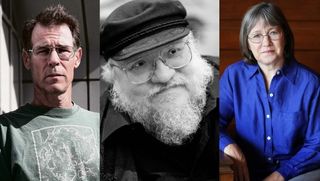Like SFX magazine, top SF and fantasy book imprint Harper Voyager launched back in 1995. A lot's happened over that 20 years, as science fiction and fantasy have become the biggest genres on the planet, and literary behemoths like The Lord Of The Rings and Game Of Thrones have conquered screens big and small.
To mark the occasion, the publisher has assembled some top genre names for a documentary about its history (which you can watch below). We’ve also spoken with publishing director Jane Johnson about two decades of SF and fantasy history...
What prompted the launch of Voyager 20 years ago?
Jane Johnson: When I joined HarperCollins in 1991 there were SFF titles published under a number of existing publishing imprints, including Fontana (Stephen Donaldson) and Grafton (Eddings, Asimov, Feist), as well as my lists at Unwin Hyman (Megan Lindholm, Guy Gavriel Kay, Geoff Ryman, Kim Stanley Robinson) – it was all a bit unwieldy. My main concern at the beginning of that time was to oversee the successful celebration of the centenary of JRR Tolkien in 1992, for which I was at that time responsible.
After that, I was asked to turn my attention to bringing together all of our fantasy and science fiction under a single banner, and to come up with an imprint name which would give a sense of the nature and quality of the list. The marketing team came up with Icon, which I couldn’t live with, so after a brainstorm with my publishing team I decided on Voyager – “for travellers of the imagination”.
How did the SF&F scene then compare to that of now?
JJ: The Net Book Agreement was still in place (until September 1995). This meant that the price publishers printed on the book was the price at which it was sold throughout the book trade: so profit margins were higher, although by modern standards, quantities sold were often lower. Fantasy hardbacks, in particular, sold very strongly throughout the trade: a new Eddings was guaranteed to go straight to number one in the bestseller lists and was cause for huge celebration.
Sign up to the SFX Newsletter
Get sneak previews, exclusive competitions and details of special events each month!
Targeted bookshop marketing – complete with posters, fliers, bookmarks and other point-of-sale material – meant that we could reach the readers very directly, and that resulted in strong paperback sales too. At that time sales of the paperback backlist was the engine of any fiction publisher, and particularly a publisher of sff, since many of the titles worked as part of a series and therefore sold in positive feedback loops, accumulating ever greater sales.

On the other hand, the books were usually to be found in dedicated space at the back of shops, where only the committed fan was likely to venture, and there was a fair bit of snobbery around in the bookshops, despite (or maybe even because of) our commercial success.
When we launched Voyager it was in tandem with independent bookchain Hammicks, with whom we ran a loyalty card scheme – like a book club – with fans getting a free Voyager title after buying a certain number of books. And we had a dedicated website, from which we could sell direct to fans. We were the first list to embrace the digital age in this way. Then we had a management change, and marketing emphasis was shifted away from SFF to women’s fiction and thrillers: with the fall of the NBA, supermarkets were suddenly driving the industry, complete with deep discounting and huge returns, and they decided their customers would not buy SFF titles in their stores. From that time on, publishing in the field became much more of a struggle.
If the you from 20 years ago could have seen the genre landscape of today, what would have surprised you most about it?
Seeing George RR Martin at the top of every sales chart, displays of his books dominating every bookshop; new fantasy titles packaged in a far more mainstream fashion – something I started to do at Voyager very soon in my stewardship after testing covers on a wide array of fiction readers, since I was convinced that there were a lot of potential readers for writers like Robin Hobb and GRRM who did not identify themselves as specifically “fantasy readers” and were put off by overtly generic packaging.
Much as I loved fantasy artwork, I had to do everything I could to carry our authors’ books to the widest possible audience in order to get them selling at a level which would deliver the best possible results and royalties. I love walking into a Waterstones or an independent bookseller like the Edge of the World bookshop and finding a Joe Abercrombie or Mark Lawrence novel sitting on a New Fiction table alongside Bernard Cornwell, Neal Stephenson and Gillian Flynn.
And then the whole digital revolution gave us greater access to our readers, both through social media and the ability to download entire novels. We had published William Gibson’s Neuromancer and Johnny Mnemonic and Pat Cadigan’s Synners – but even so I don’t think any of us foresaw ebooks coming out of cyberspace!

What have been your personal highlights over the last 20 years?
The two biggest triumphs in that time have obviously been those of George RR Martin and Robin Hobb (above with Kim Stanley Robinson). Game Of Thrones has become a truly global cultural phenomenon, referenced by leaders of the free world, comedians, Hollywood royalty and sporting superstars. What a magical – and for George, so well deserved – thing to have happened: although that level of fame is never comfortable for those suffering it on a personal level.
I had published Megan Lindholm for some years at Unwin Hyman before she “became” Robin Hobb. Launching Assassin's Apprentice with a full-scale marketing campaign that carried it onto the bestseller list was a moment of huge satisfaction, which reached an apogee last year when – just as Fool's Assassin (the 14th book in that series) went to #4 on the bestseller list – she shared a stage at the Freemason’s Hall with George RR Martin in an event that was livestreamed around the world, and Apple featured Assassin's Apprentice on the iBooks store around their iOS8 launch.
Seeing Peter Jackson film The Lord Of The Rings so beautifully, to such universal acclaim, was a thrill for me. In an attempt to steer the perception of Middle-earth away from the primary colours of the Hildebrandt brothers I had commissioned Alan Lee and John Howe to illustrate Tolkien’s world in books and calendars for years. Peter told me those paintings I commissioned formed the basis of his vision of Middle-earth: so visiting New Zealand to see that vision come to life – and then seeing it on the big screen at the Cannes Film Festival, the Oscars and premieres around the world – was so extraordinary: an unforgettable, surreal period of my life.
Publishing highlights in the past 20 years? There are a lot – [here are just two]:
Discovering and publishing the uniquely talented Mark Lawrence who is, for me, one of the finest stylists and one of the most subtle storytellers in the modern field. Uncompromising, lyrical, violent and laugh-out-loud funny, his books have been a complete revelation in showing just what epic fantasy – so often (and so wrongly) denigrated as a worn-out, threadbare genre – can deliver in the best writers’ hands.
Buying Joe Abercrombie’s marvellous YA series – Half A King, Half The World and Half A War – in a hotly contested negotiation. We’ve been so proud to publish these fantastic books and to work with Joe: it’s been huge fun, a challenge that we met on all fronts, and a a matter of great pride to see the very best of what HarperCollins in general, and Voyager in particular, can achieve with all guns blazing.
For more on top sci-fi and fantasy, subscribe to SFX
SFX Magazine is the world's number one sci-fi, fantasy, and horror magazine published by Future PLC. Established in 1995, SFX Magazine prides itself on writing for its fans, welcoming geeks, collectors, and aficionados into its readership for over 25 years. Covering films, TV shows, books, comics, games, merch, and more, SFX Magazine is published every month. If you love it, chances are we do too and you'll find it in SFX.













